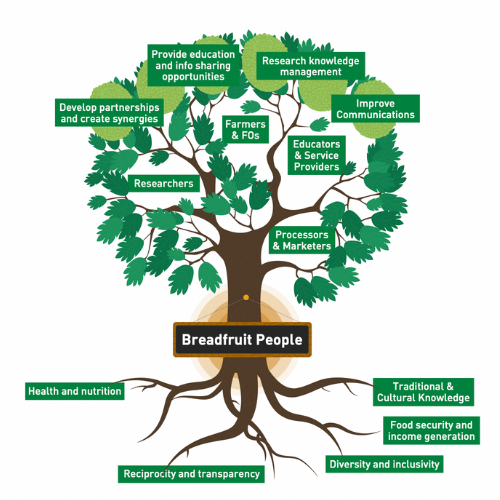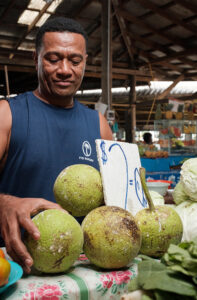What is “Breadfruit People”?
We are a community for all things breadfruit.
We have established this online community for growers, consumers, traders, processors, researchers and lovers of breadfruit. Our aim is to encourage more people to grow, buy, eat and use breadfruit and to also connect with those already working with the crop.
Why Breadfruit?
Breadfruit is a crop that just doesn’t get enough props. Why do we say this, let us give you a few proof points:
- It’s a hardy crop that’s climate resilient, even after tough weather the tree keeps growing and fruiting.
- It has a wide variety of uses as a food source, from taco chips to gnocchi or just as a side, Breadfruit is a great alternative to other starches.
- It’s low GI, gluten free and super versatile.
- Breadfruit trees take about 4 years to fruit, but after that the tree keeps growing and continues to produce fruit for many, many years.
- Breadfruit trees live for around 80 years- sometimes even more.
- The Breadfruit tree is one of the highest-yielding food plants, with a single tree producing approximately between 50 and 150 or more grapefruit-sized fruit per season.
- In its lifetime each tree can produce an average of 7,600 fruit and the great performers can double this yield.
- Once established, the trees require limited care.
We believe it’s the fruit of the future.

The tree that shares so much goodness
Just as the breadfruit tree shares so much goodness, the Breadfruit People is here to help you connect and share information on breadfruit.
From growing, to processing, to eating, and then marketing we share some interesting stories and help connect you with some breadfruit Champions doing some incredible work with our wonder fruit.
We love this graphic of a breadfruit tree that shows how Breadfruit People connects information and people.
You can read more about Breadfruit People in our Strategic Plan.
Let us introduce you to our favourite fruit – the breadfruit
It’s versatile, tasty, and can be used at all stages of development.
_____________
Breadfruit can be used at all stages of development and prepared in many ways. It is typically eaten at the mature, starchy stage when it is often used as a potato substitute in many dishes. It can be baked, steamed, boiled, fried, microwaved, grilled, barbecued, and more. The fruit can be processed into baked goods such as bread, pastries, cookies, crackers, pies, and dips, chips or other snacks, and more, or dried and ground into gluten-free flour. Ripe fruit is sweet and can be eaten raw or used to make beverages, pies, cakes, and other desserts and sweets. Small, immature fruit can be boiled, pickled or marinated, and has a flavor similar to that of artichoke hearts. There are many culinary possibilities for this versatile fruit, as well as opportunities for entrepreneurs to produce and sell breadfruit-based products, in addition to using the fresh fruit.
When properly prepared, breadfruit is delicious. Since only soft, ripe breadfruit can be eaten raw, the most common way to eat breadfruit is to first cook it. Firm, mature breadfruit can be eaten by itself with minimal to no seasoning, or replace any starchy root vegetable like a potato in almost any recipe. There are as many ways to cook breadfruit as there are varieties, but a few basic handling methods lay the groundwork for dishes from simple to elaborate.
 Handling
Handling
Simply put, handling your breadfruit correctly before cooking will make it taste better. Follow these basic handling tips any time you prepare your fruit:
Removing Stem
Twist or snap off the stem and turn the fruit upside down will allow any sticky latex to drain out. Do this the day before or a few hours prior to cooking the fruit.
Washing
Washing before cooking removes sap. Knives should be washed repeatedly to ensure sap does not dry on the blades and handles and create a sticky residue.
Cutting
Cutting off the “top” of the fruit where the stem sticks out will make a flat spot to stand the fruit on end, and prevents it from rolling or slipping when making the next cut. Quartering or cutting it into smaller chunks makes the fruit makes it easier to steam and boil.
Coring
Coring the fruit means removing the fruit’s hard central core. This can be done before or after cooking.
Peeling
Peeling the skin can be done before or after cooking, but the skin will be much easier to remove post-cooking with a paring knife or peeler. There have been a lot of experiments conducted with many different vegetable peelers, and it was found that peelers with a wide, horizontal blade work best. Micronesians use sharpened cowrie shells to peel uncooked skin and get the job done in seconds flat!
Roasting
Roasting breadfruit dates back thousands of years, and the method hasn’t changed all that much today. Fruit can be roasted whole on an open flame or barbeque until the skin is blackened and peeling, then cut and eaten like a baked potato. In a conventional oven, cut fruit into halves and place flesh side down in a baking pan with an inch of water. Bake until easily pierced with a knife or fork.
Steaming
Steaming breadfruit is a great way to keep fruit hydrated while cooking. Cut the fruit (peeled or not peeled) into quarters or smaller pieces to fit in the pot. The fruit is fully cooked when it can easily be cut with a fork. Steam fully or halfway to freeze and store for future use.
Boiling
Boiling fruit until tender is another simple and widely used method. As with steaming, cut the fruit into quarters or smaller pieces to fit in the pot. Skin can be removed before or after. Boil fully or halfway to freeze and store for future use. When boiled until soft, breadfruit can be mashed and eaten just like mashed potatoes.
Frying
Frying breadfruit in cooking oils or butter until golden brown produces a delicious crisp outside with a savory inside. In Hawaii, Tahiti, Costa Rica, and many other countries, breadfruit “fries” are already replacing potato French fries on many restaurant menus.
Freezing
Freezing cooked breadfruit is the best way to store it for future use. We have tried many methods and found that by allowing the cooked fruit to cool and placing it directly on the freezer rack, fewer ice crystals will form. Once frozen solid, place in freezer bags.
